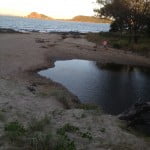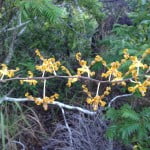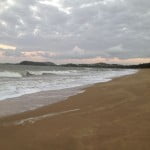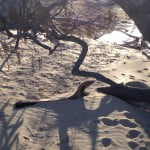I have a home not far from an ICOLL (Intermittently Closed and Open Lake and/or Lagoon) at the bottom of Lammermoor Creek on the Capricorn Coast.
There is a sandbar across the top of the lagoon that stops it emptying at low tide, but allows the sea to fill it on a very high tide.
That was until very recently when the sea pushed in a whole lot more sand, in fact so much sand that the tide can’t top the lagoon up with water at the moment. From the pictures you can see that the trunk of the casuarina in April was high above the lagoon, but now is partially covered in sand.
If this were the Lower Murray ‘they’ would blame the upstream irrigators.
Season’s Greetings.
****
Click on each photograph to bring up the individual image, and then click a second time to bring up a larger, clearer image… the orchid is especially good in close-up. The last image, photograph looking down at the last of the water in the drying lagoon, is much clearer in close-up. You can see my beautiful daughter if you look at the close-up of the second last image.








 Jennifer Marohasy BSc PhD is a critical thinker with expertise in the scientific method.
Jennifer Marohasy BSc PhD is a critical thinker with expertise in the scientific method.

The Casuarinaceae is an amazing family that includes four genera and about 70 species of trees, that include the genus Allocasuarina and Casuarina that have species on the Capricorn Coast and only about 5 species are found there from these two genus.
Casuarina equisetifolia and Casuarina cunninghamiana would be the main two species, but the photo above you’ve called “Note Casuarina” may be either one of these, but seems to look different. Because the change in genus indicates a change of conditions, and I think this may be an Allocasuarina littoralis (or Black She-oak) which can be distinguished by it’s flowering appearing reddish rather that brown.
It’s definitely a changing environment, and wonderful photos, that seem to indicate a transition from beach to rear dune status, the Black she-oak loves sand and poor soil.
Has this transition been happening over the last 15 to 20 years or so, the emptying part I mean?
Hey DaveMyFace,
Thanks for the insightful, expert commentary.
The top two photographs were taken in May or April this year. So, just a few months ago. The bottom two photographs, where the sand is now covering part of the trunk of the could be Allocasuarina littoralis, were taken just yesterday. So a very significant change in just a few months.
It will be interesting to see if the next flood can move that new sand. I’ve been walking this stretch of beach for about four years now and it is ever changing.
Hey Everyone,
I’m travelling off shore for a few days from tomorrow, so please be good, and patient if your comments get stuck in pending, I may not be back until New Year. Note, more than five hyperlinks and your comment will be swallowed.
Best wishes and thanks for your friendship…
I hate it when Jen says “be good”.
Remember don’t mistake the passion for the topic and the dialectic as personal (you scum 🙂 )
Seasons greetings and have a reflective arbitrary space/time transition to 2014, and keep safe.
Thanks for the great photos Jen. Where ‘ja get that orchid and is it a native Cymbidium?
Yep, that’s what you get with small vol creeks that flow into the ocean and it will stay like that until it floods and even then eventually return.
DaveMF that’s a C.equisetifolia. C. littoralis usually wont grow on the front dune.
Merry Christmas to all!!!
Thanks spangled drongo,
Yep, it is a Casuarina equisetifolia, TA.
The orchid is a hard one, it’s a Cepobaculum (old Dendrobium) for sure but which of the seven species but I can’t match it to any of them, especially being that far south. The Cepobaculum tattonianum is the only one that grows as far as Rockhampton. Good link here for the orchids of Australia.
http://www.anbg.gov.au/cpbr/cd-keys/orchidkey/html/commonnames.html
Cepobaculum canaliculatum
Cepobaculum carronii
Cepobaculum foelschei
Cepobaculum johannis
Cepobaculum semifuscum
Cepobaculum tattonianum
Cepobaculum trilamellatum
I reckon it may be worth while for Jennifer to send photo to Qld herbarium or the ANBG, looks like a new one? Plus the green ants ask another question, what are they feeding on, as wasps normally fertilise these orchid species?
But beautiful photo that’s for sure.
Nice photos Jennifer, but I’m not much of expert on these coastal species. All the best to everyone for a merry Xmas and a happy and safe new year.
Dave, well spotted. Ex Dendrobium. It looks a bit like this one:
http://en.wikipedia.org/wiki/File:Cepobaculum_semifuscum_flower.jpg
http://www.oznativeplants.com/plantdetail/Antelope-Orchid/Cepobaculum/semifuscum/zz.html
Spangled,
Yeah, I looked at that, but lowest point it’s been found to date is Cooktown. Jennifers photo shows a very different petal colour and shape. Maybe new.
Here’s the details on Cepobaculum semifuscum
http://keys.trin.org.au/key-server/data/08090a09-0d0e-410b-860c-020705070e0e/media/Html/Cepobaculum_semifuscum.htm
I really think this is a new one, and can’t find anything remotely close.
DaveMyFace
you are right, put them side by side and the flowers are nothing alike.
Speaking of casuarinas, I have just been feasting my eyes on a family of rare Glossy Black Cockatoos feeding in a C. torulosa.
They used to range from Mackay to Kangaroo Is. but they are hard to find these days.
In the last few days we have favoured with a visit from about 8 of them for the first time in months.
We’ve also been getting a few native Dipodium orchids lately but the dry weather has been reducing their flowering time.
Hi Jennifer,
Best wishes for the coming year. May all of your wishes come true. BTW, I’m glad that you have a beautiful place to retreat to, to recharge your batteries, after doing battle with the Forces of Darkness. 🙂
The pic shows the Foresthill Bridge from the Lake Clementine Trail. This is one of my favorite quickie hikes; it’s only a 35 min drive to the trailhead.
http://tedmuller.us/Outdoor/Hiking/2008/2008img/Mar30/BridgeAndBiker.jpg
The smoky-green color belongs to Digger Pines. The seeds are good to eat.
There’s a story behind the bridge. It’s monument to bad land use planning.
Best Christmas wishes to you, Jennifer. And to all the denizens here at this site.
Luke: Total agreement on dialectic. You bastard. ;^)
May 2014 make more sense than 2013.
Happy Christmas and New Year all.
Travellers, please be aware that our lovely forests are having their seven-yearly cicada eisteddford at the moment. I’ve just been staying near Kings Cross for some peace and quiet.
All you dopey warmies, rest assured there will be plenty of such extreme natural events in the New Year. Lots of stuff will be worse than we thought, so you’ll do okay in 2014. Dopes.